Baton Rouge, LA - The state of Louisiana is full of great historic and cultural sites which are celebrated near and far. Sometimes these historic sites suffer neglect and are threatened to be lost forever, unless there is change. Since 1999, the Louisiana Trust for Historic Preservation has identified these endangered historic places to advocate for their preservation and protection.
Over 140 sites have been nominated to date – 19 have been lost, 38 have been rehabilitated, the rest remain actively threatened, including this year’s 11 new sites. Listing these places acknowledges their importance to the local community but also our statewide identity and economy. The list is generated from nominations made by the public and aims to attract creative approaches and resources to see the sites saved and rehabilitated for future generations.
“Historic buildings and sites are the fingerprints of our communities and it takes creative measures to preserve and protect them for future generations,” says Brian Davis, Executive Director of the Louisiana Trust. “Strategic partnerships, tax credits and programs like LTHP’s revolving fund can save buildings many people may consider too far gone.”
Selections to Louisiana’s Most Endangered Places List are based on their historic significance; the critical nature of their threat; and the likelihood to bring about a positive resolution to their situation or to those of similar sites. More information about the program, including nomination form and a complete list of sites may be found at LTHP.org/properties/most-endangered/.
2020 Additions to Louisiana’s Most Endangered Places List:
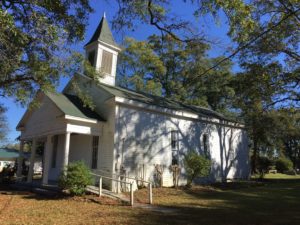 Alto Presbyterian Church (Alto, Richland Parish – 1873) – The Alto Presbyterian Church was founded in 1872 and opened this sanctuary the following year. This vernacular frame building was constructed with local cypress. The front porch and additional Sunday School rooms were added during the “gas boom” of the 1920s and 1930s. Legend has it that the steeple’s brass bell is from the very last steamboat that traversed the Boeuf River.
Alto Presbyterian Church (Alto, Richland Parish – 1873) – The Alto Presbyterian Church was founded in 1872 and opened this sanctuary the following year. This vernacular frame building was constructed with local cypress. The front porch and additional Sunday School rooms were added during the “gas boom” of the 1920s and 1930s. Legend has it that the steeple’s brass bell is from the very last steamboat that traversed the Boeuf River.
Inquiries for weddings and events continue to come in, but the church must decline due to the severe structural damage. Currently, the church only holds service once a quarter. The congregation is working to repair and raise the foundation, improve drainage, rewire for updated safety and efficiency, and make the building a water-tight place to gather again. The Church has received a $20,000 grant from the D. Thomason Fund of the First Presbyterian Church of Shreveport and continues other fundraising efforts to complete the necessary renovations.
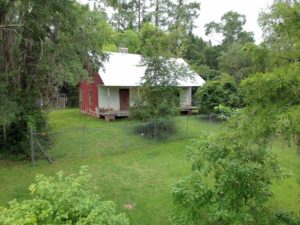 Camp Salmen Lodge (Slidell, St. Tammany Parish – c. 1790) – Located on Bayou Liberty, this building is one of the oldest still standing in St. Tammany Parish. Although speculated dates of construction range from 1750 to 1830, Joseph Laurent’s ownership of the site included 1809 to 1814. Laurent used his schooner to transport bricks and lumber across Lake Ponchartrain, to the growing city of New Orleans. The building was constructed as a residence and later served as a trading post. The land surrounding the structure became part of the Salmen Brick and Lumber Company in 1901. This company went on to build nearby railroad tracks, leading to the development of Slidell.
Camp Salmen Lodge (Slidell, St. Tammany Parish – c. 1790) – Located on Bayou Liberty, this building is one of the oldest still standing in St. Tammany Parish. Although speculated dates of construction range from 1750 to 1830, Joseph Laurent’s ownership of the site included 1809 to 1814. Laurent used his schooner to transport bricks and lumber across Lake Ponchartrain, to the growing city of New Orleans. The building was constructed as a residence and later served as a trading post. The land surrounding the structure became part of the Salmen Brick and Lumber Company in 1901. This company went on to build nearby railroad tracks, leading to the development of Slidell.
By the 1920s, much of the property’s resources had been extracted and the land was donated to the New Orleans Council of the Boy Scouts (#9544). This structure primarily served as the scoutmaster’s residence, with the surrounding land used as a retreat up until the 1980s. In 2001, the property was purchased by the Trust for Public Lands on behalf of St. Tammany Parish to protect its natural features and deter encroaching development. Today, the Friends of Camp Salmen Nature Park are working to save this Creole cottage structure as a key component of the park. The roof was upgraded in 2017, but additional work has been delayed due to limited funding.
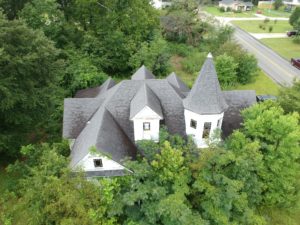 Garland House (Bernice, Union Parish – 1902) – This Queen Anne style home was built circa 1902 and was once the residence to one of the most well-known physicians in northern Louisiana, Dr. D.B. Garland, and his wife, Daisy. Its most prominent feature is its turret and a mix of roof line gables and dormers. The property was individually listed on the National Register of Historic Places in 1997 and is located within the newly designated Louisiana Cultural District. These designations make the property potentially eligible for both state and federal rehabilitation tax credit programs.
Garland House (Bernice, Union Parish – 1902) – This Queen Anne style home was built circa 1902 and was once the residence to one of the most well-known physicians in northern Louisiana, Dr. D.B. Garland, and his wife, Daisy. Its most prominent feature is its turret and a mix of roof line gables and dormers. The property was individually listed on the National Register of Historic Places in 1997 and is located within the newly designated Louisiana Cultural District. These designations make the property potentially eligible for both state and federal rehabilitation tax credit programs.
The property suffers from neglect and overgrown vegetation. Local community advocates hope to save and restore the building to help improve the appearance of both the historic house and the community.
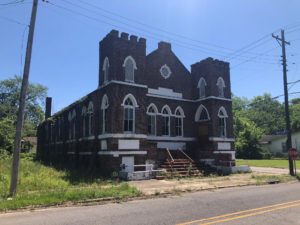 Greater New Guide Baptist Church (Baton Rouge, East Baton Rouge Parish -1930) – At the intersection of Spanish Town Road and North 19th Street sits an impressive Gothic Revival church. The New Guide Baptist Church was organized by Reverend Ike Kelly in the Scotlandville area of Baton Rouge in the early 20th century. The small group moved to a timber-framed church at this site on North 19th Street in 1914.
Greater New Guide Baptist Church (Baton Rouge, East Baton Rouge Parish -1930) – At the intersection of Spanish Town Road and North 19th Street sits an impressive Gothic Revival church. The New Guide Baptist Church was organized by Reverend Ike Kelly in the Scotlandville area of Baton Rouge in the early 20th century. The small group moved to a timber-framed church at this site on North 19th Street in 1914.
As the congregation grew during the 1920s. Reverend Thomas A. Levy worked to build a larger sanctuary and dedicated this facility in 1930. During the 1960s, Greater New Guide Baptist Church became a gathering place where the African-American community met, organized, and created strategies to fight for their Civil Rights. Membership continued to grow into the 1970s and the congregation relocated to a larger facility.
The building now sits vacant with a leaking roof, rotted window sills, and bio-growth in between bricks and downspouts. Chez Fab Arts, a local arts non-profit, is hoping to change that and revive this site as a community space for artists and events. Additional funding and support are needed to help address the conditions of the building before further programming may be developed.
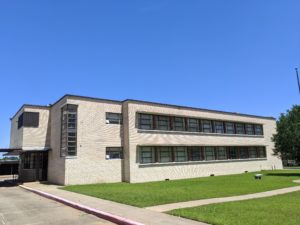 Haughton High School – H Wing (Haughton, Bossier Parish – 1939) – Haughton High School’s “H Wing” is a classic example of early Modern architecture. It was designed by prolific architect Samuel G. Wiener in 1939. Wiener designed several schools for African American students prior to World War II, however none of those schools survive today. Only three other schools designed by Wiener prior to World War II currently survive, including nearby Bossier City High School.
Haughton High School – H Wing (Haughton, Bossier Parish – 1939) – Haughton High School’s “H Wing” is a classic example of early Modern architecture. It was designed by prolific architect Samuel G. Wiener in 1939. Wiener designed several schools for African American students prior to World War II, however none of those schools survive today. Only three other schools designed by Wiener prior to World War II currently survive, including nearby Bossier City High School.
This building is important as an example of early modernism in America, heavily influenced by European design. This is a result of a trip to Europe in 1931, where he observed the new approach to using materials, light and spatial arrangement in the field of architecture. His designs following World War II show a marked influence of American interpretation of European design.
At Haughton, Wiener used Modern elements such as a vertical corner window in conjunction with a stairwell as well as cast-in-place concrete sunscreens over classroom windows. Additions were expanded onto the campus and reflected design elements from the historic building. Haughton High School is still an active learning space but the original “H-Wing” is being considered for demolition in upcoming school years due to prohibitive high maintenance and upkeep costs. The Bossier Parish School Board’s allocation of funding for physical assets is still closely reviewed by the Justice Department, following a desegregation lawsuit in the 1970s.
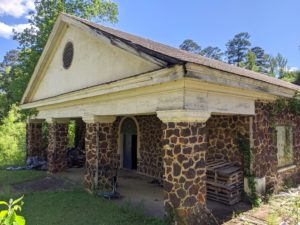 Homer Community Center (Homer, Claiborne Parish – 1939) – The Homer Community Center was built in the mid-1930s by the Works Progress Administration next to a picturesque lake. It features the popular “National Park Service Rustic” architectural style which used natural materials found throughout the surrounding area.
Homer Community Center (Homer, Claiborne Parish – 1939) – The Homer Community Center was built in the mid-1930s by the Works Progress Administration next to a picturesque lake. It features the popular “National Park Service Rustic” architectural style which used natural materials found throughout the surrounding area.
It quickly became the gathering space for community residents. By the mid-1940s, the American Legion took control of the property and it became known as the “American Legion Hut.” This building hosted countless events including proms, sporting activities, political debates, and the Homer Hayride – where musicians performed on Saturday nights to large crowds in the 1950s and 1960s.
The building was used frequently up until the 1980s, when it became utilized for municipal storage. The Homer Historic Commission hopes to nominate the building to the National Register and develop long term plans to revive the building and surrounding land as an event space for the community once again.
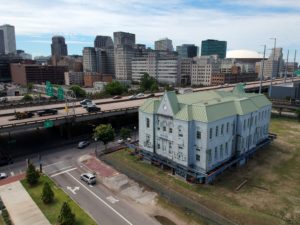 McDonough School No. 11 (New Orleans, Orleans Parish – 1879) – This school was constructed in 1879 as a girl’s grammar school within New Orleans’ Mid-City neighborhood. It is a classic example of Second Empire style and was designed by famed local architect William A. Freret. The school was also one of the first schools in New Orleans to desegregate in 1961 and continued to serve students, later becoming the New Orleans Center for Health Careers until Hurricane Katrina struck the region in 2005.
McDonough School No. 11 (New Orleans, Orleans Parish – 1879) – This school was constructed in 1879 as a girl’s grammar school within New Orleans’ Mid-City neighborhood. It is a classic example of Second Empire style and was designed by famed local architect William A. Freret. The school was also one of the first schools in New Orleans to desegregate in 1961 and continued to serve students, later becoming the New Orleans Center for Health Careers until Hurricane Katrina struck the region in 2005.
In 2011, McDonough School No. 11 was on the move. The school was moved multiple times to make room for the University Medical Complex, and it was placed on temporary supports on which it still sits today. It is highly visible from Interstate 10, where traffic can view open and broken windows, water damage, and other issues due to exposure to the elements and vandalism. This property has been listed on the New Orleans Nine Most Endangered list twice (2008 before moving and again in 2019). If current owners, LSU A&M Board of Supervisors, are willing to part with the building, it must be moved again to a permanent location for reconstruction and restoration.
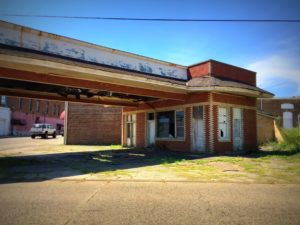 Pan Am Petroleum Corporation Gas Station – (Homer, Claiborne Parish – 1922) – This building was constructed during the golden era of the automobile and later adapted for a mix of uses, ranging from a dry-cleaning business to a popular burger joint. It has remained vacant since 1995. It was one of seven gas stations built in Homer during the early 20th century, but today it remains the sole survivor of this era.
Pan Am Petroleum Corporation Gas Station – (Homer, Claiborne Parish – 1922) – This building was constructed during the golden era of the automobile and later adapted for a mix of uses, ranging from a dry-cleaning business to a popular burger joint. It has remained vacant since 1995. It was one of seven gas stations built in Homer during the early 20th century, but today it remains the sole survivor of this era.
Just one block from the downtown Homer Square, its Arts and Crafts style stands out for its distinct brick color combinations, patterns, and singular column to the porte-cochere. It is a contributing building to the Homer National Register Historic District, which was created in 1986. The Homer Historic Commission and Main Street Homer have begun improvements to this site and its neighboring lot.
The current owner is considering a donation of the property to Main Street Homer, so the site may be rehabilitated into a multi-parish farmer’s market and serve as a catalyst for future redevelopment of the area.
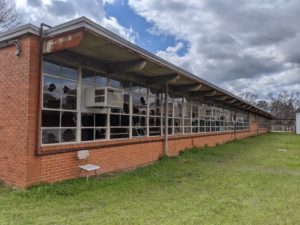 Sabine High School (Many, Sabine Parish – 1957) – The Sabine High School was built in 1957, as a modern campus to educate African American children in Sabine Parish, ranging from kindergarten to 12th grade. Designed by Shreveport architects, Seymour Van Os and Theodore Flaxman, the campus served as Many Junior High School, after desegregation in 1970. Classes in the facility ceased in 2001 and today, much of the campus’ interior is deteriorating. In spite of this, the school retains its original character-defining features such as the large expanses of ribbon windows amidst red brick walls.
Sabine High School (Many, Sabine Parish – 1957) – The Sabine High School was built in 1957, as a modern campus to educate African American children in Sabine Parish, ranging from kindergarten to 12th grade. Designed by Shreveport architects, Seymour Van Os and Theodore Flaxman, the campus served as Many Junior High School, after desegregation in 1970. Classes in the facility ceased in 2001 and today, much of the campus’ interior is deteriorating. In spite of this, the school retains its original character-defining features such as the large expanses of ribbon windows amidst red brick walls.
Sabine High School has a strong, proud alumni network and today local advocates are working to save their school. The “Exploratory Committee of the 12th District” is working to identify new uses that fit the building complex and the surrounding community such as educational and workforce programming, event and entertainment venue, senior living, or a community center. Sabine High School was added to the National Register of Historic Places in 2020.
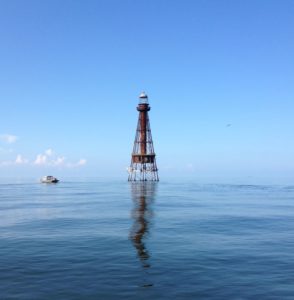 Ship Shoal Lighthouse (Gulf of Mexico, south of St. Mary Parish – 1859) – 55 miles from the coast of Louisiana rests a screw-pile designed lighthouse marking the site a large underwater sand bar. The state of Louisiana petitioned the federal government in 1848 for a lighthouse. As a result, the Pleaston Lightship was stationed on the shoal in 1849 until a permanent structure was built a decade later. The lighthouse showed signs of leaning starting in 1870 and rip-rap and granite blocks were installed to slow the shifting of sand until the light was abandoned in 1965.
Ship Shoal Lighthouse (Gulf of Mexico, south of St. Mary Parish – 1859) – 55 miles from the coast of Louisiana rests a screw-pile designed lighthouse marking the site a large underwater sand bar. The state of Louisiana petitioned the federal government in 1848 for a lighthouse. As a result, the Pleaston Lightship was stationed on the shoal in 1849 until a permanent structure was built a decade later. The lighthouse showed signs of leaning starting in 1870 and rip-rap and granite blocks were installed to slow the shifting of sand until the light was abandoned in 1965.
In the 1990s, the Town of Berwick gained ownership of the tower. The community created Lighthouse Park near the 1-90 Atchafalaya Bridge anchored with the Southwest Reef Lighthouse. Community leaders and a local contractor are hoping to relocate the Ship Shoal Lighthouse to the park. If not relocated by March 2021, the federal government will repossess the 125-foot tower. Photo Credit: Newell Slaughter
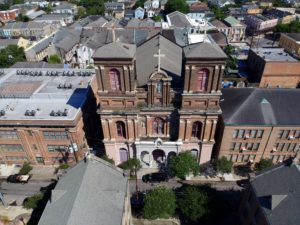 St. Alphonsus Church (New Orleans, Orleans Parish) – Built 1855-57, St. Alphonsus was designed by architect Louis L. Long to serve American and Irish Catholics. A fine example of nineteenth century Italianate architecture, it features two prominent towers as well as original handcrafted pews. Corinthian columns, Italian paintings, and German stained glass were added throughout the late 1800s.
St. Alphonsus Church (New Orleans, Orleans Parish) – Built 1855-57, St. Alphonsus was designed by architect Louis L. Long to serve American and Irish Catholics. A fine example of nineteenth century Italianate architecture, it features two prominent towers as well as original handcrafted pews. Corinthian columns, Italian paintings, and German stained glass were added throughout the late 1800s.
The Church ceased weekly religious services in 1979 and it has since been used as a cultural and event space. St. Alphonsus was listed on the National Register in 1973 and was elevated to the level of National Historic Landmark in 1996.
The Friends of St. Alphonsus have been meeting monthly since 1990 to restore this sacred space through grants and fundraisers. Their work has been limited in recent years as major improvements are needed to keep it a safe and operable space. Signs of water and termite damage can be found throughout, but especially in timbers supporting the bell tower. Heavy winds and rain have caused masonry and plaster ceiling pieces to fall. Conditions continue to worsen and citations for demolition by neglect have been issued.
__________________________
The Louisiana Trust for Historic Preservation was founded in 1979 and works in all 64 parishes to advocate, promote and preserve historic places representing our diverse culture. It is a 501(c)3 non-profit organization and for more information, visit LTHP.org or follow on Facebook (@LTHPreservation) and Instagram (@LouisianaTrust).
# # #

